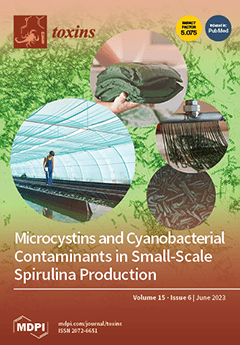Fusarium wilt, caused by
Fusarium oxysporum, is one of the most notorious diseases of cash crops. The use of microbial fungicides is an effective measure for controlling Fusarium wilt, and the genus
Bacillus is an important resource for the development of microbial
[...] Read more.
Fusarium wilt, caused by
Fusarium oxysporum, is one of the most notorious diseases of cash crops. The use of microbial fungicides is an effective measure for controlling Fusarium wilt, and the genus
Bacillus is an important resource for the development of microbial fungicides. Fusaric acid (FA) produced by
F. oxysporum can inhibit the growth of
Bacillus, thus affecting the control efficacy of microbial fungicides. Therefore, screening FA-tolerant biocontrol
Bacillus may help to improve the biocontrol effect on Fusarium wilt. In this study, a method for screening biocontrol agents against Fusarium wilt was established based on tolerance to FA and antagonism against
F. oxysporum. Three promising biocontrol bacteria, named B31, F68, and 30833, were obtained to successfully control tomato, watermelon, and cucumber Fusarium wilt. Strains B31, F68, and 30833 were identified as
B. velezensis by phylogenetic analysis of the 16S rDNA,
gyrB,
rpoB, and
rpoC gene sequences. Coculture assays revealed that strains B31, F68, and 30833 showed increased tolerance to
F. oxysporum and its metabolites compared with
B. velezensis strain FZB42. Further experiments confirmed that 10 µg/mL FA completely inhibited the growth of strain FZB42, while strains B31, F68, and 30833 maintained normal growth at 20 µg/mL FA and partial growth at 40 µg/mL FA. Compared with strain FZB42, strains B31, F68, and 30833 exhibited significantly greater tolerance to FA.
Full article






